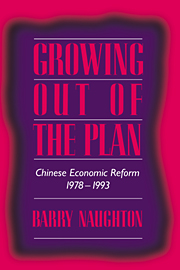Book contents
- Frontmatter
- Contents
- Tables and figures
- Preface
- Introductory
- Phase one The bird in the cage, 1979–1983
- Phase two Reforms take off, 1984–1988
- 5 Reformulation and debate: The turning point of 1984
- 6 The second phase of reform, 1984–1988
- 7 Rapid growth and macroeconomic imbalance
- Phase three To a market economy
- Statistical appendix
- Notes
- Bibliography
- Index
6 - The second phase of reform, 1984–1988
Published online by Cambridge University Press: 03 May 2010
- Frontmatter
- Contents
- Tables and figures
- Preface
- Introductory
- Phase one The bird in the cage, 1979–1983
- Phase two Reforms take off, 1984–1988
- 5 Reformulation and debate: The turning point of 1984
- 6 The second phase of reform, 1984–1988
- 7 Rapid growth and macroeconomic imbalance
- Phase three To a market economy
- Statistical appendix
- Notes
- Bibliography
- Index
Summary
The previous chapter described the acceleration of China's industrial reforms during 1984 and the new turn taken in reform policy. Although there were continuities with the first period of reform, the basic thrust of what reformers were trying to accomplish changed. Reformers, led by Zhao Ziyang, now had an idea of what they were attempting to accomplish as well as a general approach to the process of reform that informed specific policy measures. This approach never added up to a comprehensive strategy of reform, but it had an internal logic and consistency of application that justifies our labeling it a reform strategy. The essence of that strategy was to expand market forces by limiting the scope of planning, fostering entry, and improving incentives and autonomy for state-run enterprises to operate on the market. The strategy combined a dual-track (plan and market) economy with the attempt to introduce high-powered incentive for entrepreneurs even within the state sector. Successive reform measures had a cumulative impact that went a great distance toward converting China's economy to a market economy by the end of the 1980s.
In essence, Chinese leaders decided during 1984 that the buildup of government capabilities and the improvement of economic conditions that had occurred since 1978 would be used in the service of substantial economic reforms, rather than in the strengthening of the administrative economy. What is most impressive about this period beginning in 1984 was precisely that reform measures were adopted across a broad spectrum.
- Type
- Chapter
- Information
- Growing Out of the PlanChinese Economic Reform, 1978–1993, pp. 200 - 243Publisher: Cambridge University PressPrint publication year: 1995



